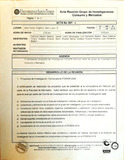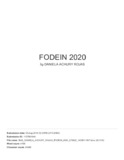Mostrar el registro sencillo del ítem
Construcción de un modelo de ecuaciones estructurales que relacione los factores de valor percibido hacia las tarjetas de crédito clásicas en población colombiana
| dc.contributor.author | Neme Chaves, Samir Ricardo | spa |
| dc.contributor.author | Forero Molina, Sara Catalina | spa |
| dc.date.accessioned | 2020-04-15T16:54:52Z | spa |
| dc.date.available | 2020-04-15T16:54:52Z | spa |
| dc.date.issued | 2019-08 | spa |
| dc.identifier.uri | http://hdl.handle.net/11634/22459 | |
| dc.description | El uso de tarjetas de crédito viene creciendo año a año en Colombia de acuerdo con la Superintendencia Financiera. En tal medida, es fundamental evaluar el impacto que las estrategias de las entidades financieras han venido teniendo en torno a las percepciones de los clientes, por lo que el valor percibido se convierte en un constructo en el que se debe fijar la atención. Así, con base en los proyectos FODEIN 2018 y FODEIN 2019, el presente proyecto tiene como objetivo construir un modelo de ecuaciones estructurales que relacione los factores de valor percibido hacia las tarjetas de crédito clásicas en población colombiana. Lo anterior, representa dos ventajas, por un lado, llenar un vacío teórico ya que no se han propuesto estudios que hayan abordado el valor percibido en las tarjetas de crédito y por el otro, garantizar la calidad de la propuesta metodológica. Por consiguiente, el análisis se llevará a cabo mediante el método multivariado de modelamiento de ecuaciones estructurales que permitirá identificar la relación entre los factores de valor percibido hacia las tarjetas de crédito clásica en población colombiana. | spa |
| dc.description.abstract | The use of credit cards has been growing year by year in Colombia according to the Financial Superintendence. As such, it is essential to evaluate the impact that the strategies of financial institutions have been having on customer perceptions, so that the perceived value becomes a construct on which attention must be focused. Thus, based on the FODEIN 2018 and FODEIN 2019 projects, this project aims to build a model of structural equations that relates the perceived value factors to classic credit cards in the Colombian population. This represents two advantages, on the one hand, filling a theoretical gap since no studies have been proposed that have addressed the perceived value of credit cards and, on the other, guaranteeing the quality of the methodological proposal. Therefore, the analysis will be carried out using the multivariate method of modeling structural equations that will allow us to identify the relationship between factors of perceived value towards classic credit cards in the Colombian population. | spa |
| dc.format.mimetype | application/pdf | spa |
| dc.rights | Atribución-NoComercial-SinDerivadas 2.5 Colombia | * |
| dc.rights.uri | http://creativecommons.org/licenses/by-nc-nd/2.5/co/ | * |
| dc.title | Construcción de un modelo de ecuaciones estructurales que relacione los factores de valor percibido hacia las tarjetas de crédito clásicas en población colombiana | spa |
| dc.subject.keyword | Structural equations | spa |
| dc.subject.keyword | Perceived value | spa |
| dc.subject.keyword | Classic credit cards | spa |
| dc.coverage.campus | CRAI-USTA Bogotá | spa |
| dc.contributor.orcid | https://orcid.org/0000-0003-2327-4947 | spa |
| dc.contributor.orcid | https://orcid.org/0000-0002-3020-0690 | spa |
| dc.contributor.googlescholar | https://scholar.google.es/citations?user=I_RekVUAAAAJ&hl=es&authuser=1 | spa |
| dc.contributor.googlescholar | https://scholar.google.es/citations?user=V4FviDYAAAAJ&hl=es | spa |
| dc.contributor.cvlac | http://scienti.colciencias.gov.co:8081/cvlac/visualizador/generarCurriculoCv.do?cod_rh=0001344193 | spa |
| dc.contributor.cvlac | http://scienti.colciencias.gov.co:8081/cvlac/visualizador/generarCurriculoCv.do?cod_rh=0001377177 | spa |
| dc.description.domain | http://unidadinvestigacion.usta.edu.co | spa |
| dc.relation.references | Bolton, R. N., & Lemon, K. N. (1999). A dynamic model of customers' usage of services: Usage as an antecedent and consequence of satisfaction. Journal of Marketing Research, 36(2), 171-186. 10.2307/3152091 | spa |
| dc.relation.references | Carter, J., & Pritchard, D. (2015). Knowledge-how and epistemic value. Australasian Journal of Philosophy, 93(4), 799-816. doi: https://doi.org/10.1080/00048402.2014.997767 | spa |
| dc.relation.references | Casas, M. (2002) Los modelos de ecuaciones estructurales y su aplicación en el Índice Europeo de Satisfacción del Cliente. Actas_10 | spa |
| dc.relation.references | Chen, C. F., & Tsai, M. H. (2008). Perceived value, satisfaction, and loyalty of TV travel product shopping: Involvement as a moderator. Tourism Management, 29(6), 1166-1171. doi: 10.1016/j.tourman.2008.02.019 | spa |
| dc.relation.references | Cronin, J. J., Brady, M. K., & Hult, G. T. M. (2000). Assessing the effects of quality, value, and customer satisfaction on consumer behavioral intentions in service environments//doi.org/10.1016/S0022-4359(00)00028-2 | spa |
| dc.relation.references | Cupani, M. (2012) Análisis de ecuaciones estructurales: Conceptos, etapas de desarrollo y un ejemplo de aplicación. Revista Tesis 1 pp 186-199 | spa |
| dc.relation.references | Eggert, A., & Ulaga, W. (2002). Customer perceived value: a substitute for satisfaction in business markets?. Journal of Business & industrial marketing, 17(2/3), 107-118. | spa |
| dc.relation.references | El Tiempo (2018). Por primera vez se lleva a 15 millones de tarjetas de crédito. Retrieved from https://www.eltiempo.com/economia/sector-financiero/usuarios-de-tarjetas-de-credito-en-colombia-2018-241960 | spa |
| dc.relation.references | Fang, B., Ye, Q., Kucukusta, D., & Law, R. (2016). Analysis of the perceived value of online tourism reviews: Influence of readability and reviewer characteristics. Tourism Management, 52, 498-506. doi: https://doi.org/10.1016/j.tourman.2015.07.018 | spa |
| dc.relation.references | Filippi, C., Guastaroba, G., & Speranza, M. G. (2017). Applications of Conditional Value-at-Risk Beyond Finance: A Literature Review. In Technical Report 2. University of Brescia, Department of Economics and Management. | spa |
| dc.relation.references | Friston, K., Rigoli, F., Ognibene, D., Mathys, C., Fitzgerald, T., & Pezzulo, G. (2015). Active inference and epistemic value. Cognitive neuroscience, 6(4), 187-214. doi: https://doi.org/10.1080/17588928.2015.1020053 | spa |
| dc.relation.references | Gamage, T. C., & Ahsan, F. J. (2013). Perceived Value of Online Services: Scale Validation and Managerial Implications. url: http://220.247.247.85:8081/handle/123456789/7914 | spa |
| dc.relation.references | García-Fernández, J., Gálvez-Ruíz, P., Fernández-Gavira, J., Vélez-Colón, L., Pitts, B., & Bernal-García, A. (2018). The effects of service convenience and perceived quality on perceived value, satisfaction and loyalty in low-cost fitness centers. Sport Management Review, 21(3), 250-262. doi: https://doi.org/10.1016/j.smr.2017.07.003 | spa |
| dc.relation.references | Greco, J., & De Sa, L. P. (2018). Epistemic Value. doi:10.4324/0123456789-P073-1 | spa |
| dc.relation.references | Henseler, J., Ringle, C. M., & Sarstedt, M. (2015). A new criterion for assessing discriminant validity in variance-based structural equation modeling. Journal of the academy of marketing science, 43(1), 115-135. | spa |
| dc.relation.references | Khare, A., Khare, A., y Singh, S. (2012). Factors affecting credit card use in India. Asia Pacific Journal of Marketing and Logistics, 24(2), 236-256 | spa |
| dc.relation.references | Kouri, D. P., & Surowiec, T. M. (2016). Risk-averse PDE-constrained optimization using the conditional value-at-risk. SIAM Journal on Optimization, 26(1), 365-396.doi:https://doi.org/10.1137/140954556 | spa |
| dc.relation.references | Kline, R. B. (2015). Principles and practice of structural equation modeling. Guilford publications. | spa |
| dc.relation.references | Lee, J., y Kwon, K-N. (2002). Consumers’ use of credit cards: store credit card usage as an alternative payment and financing medium. The Journal of Consumer Affairs, 36(2), 239-262. | spa |
| dc.relation.references | Liang, L. J., Choi, H. C., & Joppe, M. (2018). Understanding repurchase intention of Airbnb consumers: perceived authenticity, electronic word-of-mouth, and price sensitivity. Journal of Travel & Tourism Marketing, 35(1), 73-89.doi: https://doi.org/10.1080/10548408.2016.1224750 | spa |
| dc.relation.references | Linkola, J. (2018). Monetising mobile customer’s perceived value. Master’s Thesis. Aalto University. Espoo, Finland. url: http://urn.fi/URN:NBN:fi:aalto-201806293790 | spa |
| dc.relation.references | Macdonald, E. K., Kleinaltenkamp, M., & Wilson, H. N. (2016). How business customers judge solutions: Solution quality and value in use. Journal of Marketing, 80(3), 96-120. doi: 10.1509/jm.15.0109 | spa |
| dc.relation.references | McDougall, G. H., & Levesque, T. (2000). Customer satisfaction with services: putting perceived value into the equation. Journal of services marketing, 14(5), 392-410. | spa |
| dc.relation.references | MinTic (2019). Ministerio TIC hace recomendaciones para que los colombianos compren por internet de forma segura este “CiberLunes”. Retrieved from https://www.mintic.gov.co/portal/604/w3-article-101206.html | spa |
| dc.relation.references | Mueller, R. O., & Hancock, G. R. (2018). Structural equation modeling. In The reviewer’s guide to quantitative methods in the social sciences (pp. 445-456). Routledge. | spa |
| dc.relation.references | Parasuraman, A., & Grewal, D. (2000). The impact of technology on the quality-value-loyalty chain: a research agenda. Journal of the academy of marketing science, 28(1), 168-174. | spa |
| dc.relation.references | Phau, I., y Woo, C. (2008). Understanding compulsive buying tendencies among young Australians: the roles of money attitude and credit card usage. Journal of Marketing Intelligence & Planning, 26(5), 441-460. | spa |
| dc.relation.references | Pezzulo, G., Cartoni, E., Rigoli, F., Pio-Lopez, L., & Friston, K. (2016). Active Inference, epistemic value, and vicarious trial and error. Learning & Memory, 23(7), 322-338. doi:http://www.learnmem.org/cgi/doi/10.1101/lm.041780.116. | spa |
| dc.relation.references | Portafolio. (2019). Colombia, el país donde más se gasta con tarjetas en latinoamérica. Retrieved from http://www.portafolio.co/economia/finanzas/colombia-el-pais-donde-mas-se-gasta-con-tarjetas-en-latinoamerica-527128 | spa |
| dc.relation.references | Ryu, K., Lee, H. R., & Gon Kim, W. (2012). The influence of the quality of the physical environment, food, and service on restaurant image, customer perceived value, customer satisfaction, and behavioral intentions. International Journal of Contemporary Hospitality Management, 24(2), 200-223. | spa |
| dc.relation.references | Sánchez-Fernández, R., & Iniesta-Bonillo, M. Á. (2007). The concept of perceived value: a systematic review of the research. Marketing Theory, 7(4), 427–451. https://doi.org/10.1177/1470593107083165 | spa |
| dc.relation.references | Shapiro, S. L., Reams, L., & So, K. K. F. (2018). Is it worth the price? the role of perceived financial risk, identification, and perceived value in purchasing pay-per-view broadcasts of combat sports. doi. 10.1016/j.smr.2018.03.002 | spa |
| dc.relation.references | Sheth, J. N., Newman, B. I., & Gross, B. L. (1991). Why we buy what we buy: A theory of consumption values. Journal of Business Research, 22(2), 159-170. 10.1016/0148-2963(91)90050-8 | spa |
| dc.relation.references | Superintendencia Financiera de Colombia (2017). Informe de tarjetas de crédito y débito. Recuperado de https://www.superfinanciera.gov.co/inicio/informe-de-tarjetas-de-credito-y-debito-60952 | spa |
| dc.relation.references | Superintendencia Financiera de Colombia (2018). Informe de tarjetas de crédito y débito. Recuperado de https://www.superfinanciera.gov.co/inicio/informe-de-tarjetas-de-credito-y-debito-60952 | spa |
| dc.relation.references | Superintendencia Financiera de Colombia (2019). Informe de tarjetas de crédito y débito. Recuperado de https://www.superfinanciera.gov.co/inicio/informe-de-tarjetas-de-credito-y-debito-60952 | spa |
| dc.relation.references | Sweeney, J. C., Soutar, G. N., & Johnson, L. W. (1999). The role of perceived risk in the quality-value relationship: a study in a retail environment. Journal of retailing, 75(1), 77-105. doi: https://doi.org/10.1016/S0022-4359(99)80005-0 | spa |
| dc.relation.references | Yang, Z., & Peterson, R. T. (2004). Customer perceived value, satisfaction, and loyalty: The role of switching costs. Psychology & Marketing, 21(10), 799-822. doi: https://doi.org/10.1002/mar.20030 | spa |
| dc.relation.references | Yang, H., Yu, J., Zo, H., & Choi, M. (2016). User acceptance of wearable devices: An extended perspective of perceived value. Telematics and Informatics, 33(2), 256-269. doi: https://doi.org/10.1016/j.tele.2015.08.007 | spa |
| dc.relation.references | Yang, J., Gu, Y., & Cen, J. (2011). Festival tourists' emotion, perceived value, and behavioral intentions: A test of the moderating effect of festivalscape. Journal of Convention and Event Tourism, 12(1), 25-44. 10.1080/15470148.2010.551292 | spa |
| dc.relation.references | Walsh, G., Shiu, E., & Hassan, L. M. (2014). Replicating, validating, and reducing the length of the consumer perceived value scale. Journal of Business Research, 67(3), 260-267. //doi.org/10.1016/j.jbusres.2013.05.012 Retrieved from http://www.sciencedirect.com/science/article/pii/S0148296313002002 | spa |
| dc.relation.references | Wiedmann, K. P., Behrens, S., Hennigs, N., & Klarmann, C. (2016). What is the perceived value of wine? A cross-generation study of consumer wine perception and consumption behavior. In Looking Forward, Looking Back: Drawing on the Past to Shape the Future of Marketing (pp. 551-551). Springer, Cham. | spa |
| dc.relation.references | Zeithaml, V. A. (1988). Consumer perceptions of price, quality, and value: A means-end model and synthesis of evidence. Journal of Marketing, 52, 2-22. doi:10.1177/002224298805200302 | spa |
| dc.subject.proposal | Ecuaciones estructurales | spa |
| dc.subject.proposal | Valor percibido | spa |
| dc.subject.proposal | Tarjetas de crédito clásicas | spa |
| dc.type.category | Formación de Recurso Humano para la Ctel: Proyecto ejecutado con investigadores en empresas, industrias y Estado | spa |
Ficheros en el ítem
Este ítem aparece en la(s) siguiente(s) colección(ones)
-
Consumo y Mercados [144]




















